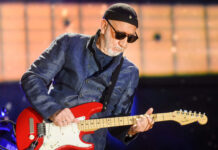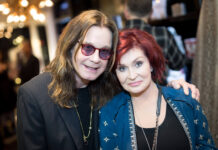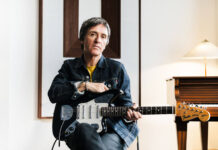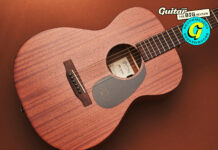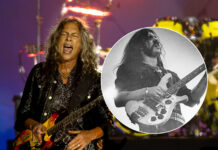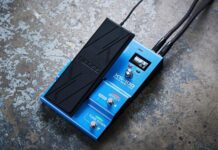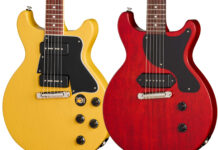
Guitar Legends: Ritchie Blackmore – the outspoken and mysterious guitar hero that slayed in the 70s
Every player has likely heard of Ritchie Blackmore. But it is plausible that he’s actually overlooked somewhat in the guitar pantheon, given the yards of coverage and acclaim given to, say, Jimmy Page? Yes, it is.
READ MORE: Guitar Legends: Rory Gallagher – the self-styled ‘working guitarist’ who was touched by genius
These two behemoths of classic British rock are broadly the same age, and have both influenced myriad players. If anything, Blackmore has trodden a more diverse path – crunching hard rock in Deep Purple, wizardly metal to pop-AOR in Rainbow and unique acoustic reveries in Blackmore’s Night. The latter will never have the cachet of Led Zeppelin III though, so – to perhaps too many – Ritchie Blackmore is someone who used to be famous. But for sheer skill, ambition and – let’s cut to the core – simply bamboozling guitar mastery, Blackmore is very much Page’s peer.
Early days
Like Page, Blackmore cut his teeth in the strange world of 60s British pop sessions. He’d taken up the guitar because he “wanted to be like Tommy Steele” (the music hall rock ’n’ roller) and even had lessons from session great ‘Big’ Jim Sullivan (mentor to ‘Little’ Jimmy Page) on the London session circuit. Blackmore worked as a lesser session player on Joe ‘Telstar’ Meek productions, famously being in Meek’s house band The Outlaws (with Chas Hodges of Chas & Dave, trivia fans), backing German singer Heinz on hit single Just Like Eddie and, like Page, also working with rock prankster Screaming Lord Sutch. Curios of Blackmore’s early career include The Outlaws’ promo single for Raleigh Bikes, Bike Beat, (“Grab a girl at random, make like a tandem”) that came with its own ‘dance’ on the sleeve. Did we mention it was the 1960s?
But Blackmore eventually started to find his own feet in the band Roundabout (from 1967) which quickly morphed into Deep Purple. The name? “It was a song my grandmother used to play on the piano.” Back then, Blackmore was just the guitar player: keyboardist Jon Lord was DP’s main writer. Treat the three Deep Purple ‘Mark I’ LPs (featuring singer Rod Evans) with caution: although not charmless, they were more frothily psychedelic pop or blues than later Purple and Page’s own bombastic New Yard Yardbirds/Led Zeppelin, and were best known for US and European hit Hush (a cover of a Billy Joe Royal song). The fleeting US fame that hit provided saw Blackmore give guitar lessons himself: to Playboy impresario Hugh Hefner. So far, so strange. A different generation will know Hush from 1997, and the version by Poundshop mystics Kula Shaker, which actually did much better in the charts (a No. 2!) than Purple’s.
In these early excursions, Blackmore favoured a red Gibson ES-335 – it was in vogue with Eric Clapton, Ten Years After’s Alvin Lee and others Blackmore admired, such as US bluesman Shuggie Otis. But from a musical point, there was also the influence of Jeff Beck: the ex-Yardbirds player’s exploration of eastern scales and timbres in a blues-rock template dovetailed with Blackmore’s own interest in music beyond rock ’n’ roll. “When Shapes Of Things [The Yardbirds, 1966] came out, everybody went, ‘Oh my God! Who is that… and why is he playing this Indian stuff? It shouldn’t be allowed.’ It was just too good.”
Outlaws. Image: Dieter Radtke – K&K / RedfernsBlackmore’s purple patch
From 1970, Deep Purple’s ‘Mark II’ lineup changed everything. Ian Gillan joined on vocals, and Blackmore increasingly led the direction of the band. “Ritchie wasn’t just the guitar player, he was a brilliant innovator,” judged bassist Roger Glover. “Things he wrote defy description. Ritchie was phenomenal in what he was doing in the late 60s and early 70s. He was a magnetic, dynamic writer.” Such vision didn’t come without friction. The first LP with Gillan was Concerto For Group And Orchestra, which Jon Lord later said had upset Blackmore because it diverted focus away from the increasingly headstrong guitarist.
“That’s true,” Blackmore concurred. “We were a rock band. I couldn’t understand why we kept playing with orchestras. I was impressed with what Zeppelin did, and I wanted to do that kind of stuff, and if it doesn’t take off we’ll go and play with orchestras the rest of our lives. So we did it, and it was Deep Purple In Rock…”
From In Rock (1970) to the live Made In Japan (1972), Purple Mk II delivered an onslaught of huge riffing, vocal wailing and guitar soloing that did much to define the metal of the 1970s. Blackmore was untouchable at this point: Black Night, the ubiquitous Smoke On The Water, Child In Time, Flight Of The Rat and many more became riffs of fable. Blackmore’s soloing became something else. In contrast to Page, he was an incredibly precise player as well as being super-fast: the likes of Highway Star, Pictures Of Home and Lazy paved the way for ‘shredding’ blues rock that was way beyond his contemporaries. When Gillan departed, to be replaced in Deep Purple Mk III by the young unknown David Coverdale (alongside bassist/co-vocalist Glenn Hughes), Blackmore upped the ante again, coining the neo-classical sound in Burn… yep, blame Blackmore, if you care, for Yngwie J Malmsteen.
In Purple, Blackmore started with his ES-335 but soon moved onto Fender Stratocasters, with which he became synonymous (see Guitars & Amps below). It allowed him much more flexibility with its vibrato, and also gave a surprisingly clean sound for a ‘heavy metal’ player.
Deep Purple. Image: Chris Walter / WireImageBlackmore’s rainbow rises
By 1975, Blackmore wasn’t overly enthralled by some of newcomer Hughes’ funkier influences, and a planned side-project with Ronnie James Dio of US rockers Elf (regular support act to Purple from 1972 onwards) soon got shaped into a full-blown new band. The Rainbow name? “It came from the Hollywood Bar & Grill (aka the Rainbow on LA’s Sunset Strip),” Blackmore explained. “I was in there with Ronnie, getting drunk as usual, and said: ‘What shall we call the band?’ and just pointed to the sign.”
Over their three studio albums together, the Dio/Blackmore partnership in Rainbow delivered some of the most grandiose rock of the decade. It’s possible to laugh now at the Spinal Tap-isms – much of the early Rainbow catalogue is probably best listened to while brandishing a sword and dressed in bearskins – but at the time it was astonishing. Blackmore’s riff-writing got even more intense with Kill The King, Man On The Silver Mountain and Long Live Rock ’n’ Roll: Dio’s penchant for ‘dungeons and dragons’ lyricism soared into orbit with Catch The Rainbow (with a haunting Hank-esque solo from Blackmore), Gates Of Babylon and the phenomenal Stargazer.
The latter has come to be known as Blackmore’s own Kashmir though – if possible – it’s even more epic than Zeppelin’s Eastern-flavoured stomper. Despite Blackmore’s earlier ‘no-orchestra’ protestations in Purple, Stargazer featured the Munich Philharmonic. Blackmore’s solo was in the Phrygian dominant scale (used in Indian ragas, Egyptian music and Flamenco) and another flag in the sand of neo-classical metal. He was by now a long way from heavy bluesy jams of early Purple. “It’s amazing how many guitarists use the same old lines,” said Blackmore of Stargazer. “They never dare touch Arabic or Turkish scales.”
True to form, the classic lineup of Rainbow slowly declined. Dio left in 1979, bassist Jimmy Bain was sacked; drummer Cozy Powell lasted until 1980. Blackmore continued to fly the Rainbow flag until 1984, albeit in increasingly chart-friendly forms, lesser members and with less ground-breaking guitar. “He was perturbed that he wasn’t being played on the radio,” reckoned Bain. Singers Graham Bonnet and Joe Lynn Turner certainly aided the AOR hits (Since You’ve Been Gone, I Surrender and others), but Rainbow started to sound like other bands, and the creative light was fading. Rising still stands tall though: back in 1981, the headbanging readership of Kerrang! magazine voted it the ‘Greatest Heavy Metal Album Ever’, and its influence on Iron Maiden, power metal, neo-classical shred and more is palpable.
Blackmore, always known as someone with wit as dry as the desert, even reflected back in 1976 of Rising: “Everybody who’s heard it thinks it’s my best playing in a long time, which I suppose is a compliment. Then again, what do they know?”
Rainbow. Image: Jorgen Angel / RedfernsBlackmore’s renaissance
Deep Purple and Rainbow have reformed at various times, but since 1997 Blackmore’s main focus has been ‘renaissance folk rock’ band Blackmore’s Night. At 24 years and 11 albums, it’s by far his longest-lasting musical portfolio… even Steve Morse has been Deep Purple’s guitarist longer than Ritchie Blackmore himself! Solving any lead-singer conflicts, Blackmore married his: Candice Night. He still breaks out his Strats on occasion, but you’re more likely to see him fretting other stringed ephemera: acoustics, a mandola, hurdy-gurdy and nyckelharpa. When he started Blackmore’s Night, he mused: “I’m finding it harder and harder to be inspired by just playing loud. I’d rather just sit down with a guitar and play. This whole ‘You’ve got to hit with a big riff’ thing is beginning to wear off.”
Blackmore’s Night certainly isn’t for everyone, but it’s no joke. He once deadpanned; “I just don’t fit into the ‘fun’ area. A lot of musicians go: ‘Oh, that was fun.’ Well, I like to think that music… is hard work and it’s really gratifying to do, but fun? Fun is something where someone tells a joke and they laugh for 10 seconds. Music’s much deeper than that.”
And remember: for all the jaw-dropping soloing, Blackmore is keen to remind others of what’s really important in guitar playing.
“If you try to play too technically, you lose something in the music—like you’re playing for another guitar player,” he says. “I like to play for people. I often think of the guitar last when I’m recording. The most important thing to me are the vocals, then comes the arrangement, then the song. And then, way down: ‘Oh yes, there has to be a guitar solo.’ But for a lot of players, everything revolves around the solo.”
Guitars & amps
When Blackmore first got a guitar aged 11, it was just the same as many others of his generation: a second-hand Framus Spanish guitar. By the early 1960s he’d become more than just a proficient youth, and he got the guitar he played for much of that decade: a 1961 Gibson ES-335, with dot markers instead of the post-1962 block inlays. It’s been suggested the serial number was 26547. It had a Bigsby B5 vibrato fitted, a replacement for the stock tailpiece, but the Tune-o-Matic bridge remained. Originally, this era ES-335 had a short pickguard and black metal-topped knobs, and Blackmore eventually replaced these with golden ones. He generally paired it with a Vox AC30. Such an ES-335 would be highly costly now – in the region of £12k, regardless of any mods – but back then it was just a ‘jobbing’, if top quality, guitar.
On sessions and in early Deep Purple, Blackmore sounded very different to later, but the 335 was his main guitar (even on early DP LPs) up to 1970. He used it up to In Rock and you can famously see footage when Deep Purple performed the Concerto For Group And Orchestra at the Royal Albert Hall (1969), and on Child In Time on Granada TV (1970). His ES-335 was also used to record that song. Even a spec-correct reissue 1961 ES-335 is now circa £4500.
Image: Jorgen Angel / RedfernsIt was 1970, when Blackmore decided he wanted a more “metallic” sounding electric. Enter his love of Fender Stratocasters. “The Strat had more of a cut for rock’n’roll; the Gibson’s more of a jazzy guitar,” he said. “It has a very mellow sound – full sound, great sound – but I when I heard Hendrix, I liked the way he cut through the notes. I wanted to try to reach that.
“I first got my Strat indirectly through Eric Clapton. He gave his roadie, who is my friend, a Strat that he didn’t want. He [the roadie] gave it to me, and that’s when I started playing the Strat.”
This was just after Clapton himself had moved from 335s to Strats and, as we know, was buying quite a few second-hand Fenders (eventually spawning Brownie and Blackie). Ritchie main first ‘CBS-era’ large-headstock 1968 Strat was a black finish with maple neck, though the fret were apparently worn and he replaced them with fatter Gibson wire. With the maple neck not re-lacquered after this mod, the fretboard would become noticeably darker over time. Around 1972, he got another very similar black Strat.
But it was between these two in 1971, that he got a sunburst Strat and that was used on Machine Head. He was still replacing the stock Fender frets with wider Gibson wire, and it’s thought the sunburst was his first Strat when – during the re-fretting process – he sanded down the fretboard to create a ‘scalloped’ profile.
Blackmore is often credited with “inventing” scalloped boards, but that’s not strictly true: tellingly, it goes back to numerous ancient instruments, particularly from the East. But there’s no question that Blackmore’s use of a scalloped ’board in the rock canon was highly influential: Yngwie Malmsteen, Joe Satriani and Steve Vai would not have travelled this route were it not for Blackmore. Don’t think a scalloped fretboard somehow automatically adds speed: indeed, you’ll probably have to play slower to begin with to avoid sharpness/flatness, particularly on chords, but, over time, it should enhance your control and dexterity. And that’s a Blackmore trait. He’s not “admirably sloppy” in the way, say, Jimmy Page is sometimes spoken of. It will make a lighter touch possible, allowing ‘economy of movement’ in your picking hand… and that’s where speed can come from.
Image: Jorgen Angel / RedfernsHe also played a 1972 black Fender Strat, with a then-new die-cast vibrato, which had a great influence on the overall tone. This bib (later installed in his other guitars) had new rectangular saddles, die-cast, and the tone was known for being rounder, softer and with a more pearly attack. You can identify the 72 Strat easily because of the “bullet truss rod” on the headstock.
He also had, in Deep Purple Mk III, a heavy-weighted 1972 Fender Strat with natural ash body. This had a scalloped fretboard, maple neck and original staggered Fender single coil pickups. This guitar had an extra fat U-shape neck, one of the reasons why it sounded so beefy, and he played this a lot up to the early Rainbow days.
In Rainbow, he then moved to a rosewood-neck 1974 model, with scalloped fretboard. This was one of his favourites – and, of course a rosewood neck was easier to scallop than a lacquered maple one. He also had, from 1978, his first hum cancelling Stratocaster (in Olympic-white) that was built by his tech. He wanted a more modern sound, and finally he choose Velvet Hammer pickups from Red Rhodes, slightly overwound Fender style pickups. He also used Bill Lawrence L-250 single-coil-sized humbuckers and, later, L-450s. And, later again, Lace Sensor pickups. He did a lot of swapping loaded pickguards between basic large-headed Strats. A lot of variations on a theme, basically.
A current option for a Strat akin to Blackmore’s might be the Fender Vintera 70s Stratocaster.
Image: Brian Rasic / Getty ImagesAmps-wise, a Vox AC30 remained in use in the studio but Blackmore became notorious for his on-stage Marshalls. He had a favourite 200-watt Marshall Major head and two cabinets, but the Major had been modded at the factory with an added output stage, increasing the volume, and the EQs were specially voiced. Theoretically, this was a 280-watt head (“the loudest amps in the world!” he said.) Those cabs that he’s thrust his Strat through for onstage pyrotechnics and drama? Cheaper copies and fakes. He’s not made of money… and smarter than to wreck proper gear like Pete Townshend. There are plenty of options to a vintage Vox AC30 now, such as this Vox Cambridge50 modelling amp.
Blackmore eventually moved to Engl Sovereign and Savage heads and combos, and has his own signature Ritchie Blackmore Engl E650 based on the Savage.
It isn’t quite as simple as a Strat+Marshall-style amp, though. In classic Deep Purple he also used a Hornby-Skewes Treble Booster and a modified AIWA tape recorder. “I modified it from a regular tape recorder to an echo unit. It also preamps and boosts the signal going to the amp. If I want a fuzzy effect l just turn up the output stage of the tape recorder,” he told Guitar Player magazine. Not the sort of thing you’d buy off the shelf. Instead, try out some treble boost pedals or even build your own. But one thing to be wary of: his tone is rarely super-distorted.
Ritchie Blackmore’s style
Outside of his great tone and actual notes, there are few things to note about Blackmore’s playing style. One thing Big Jim Sullivan taught him was to use his pinkie for fretting notes as well, something not every player does. It may be hard to master but will allow greater stretches and speed. He’s influenced loads of players, even those who don’t really sound like him.
“Ritchie was already a source of mystery and wonder – nobody could play like that in those days,” says Queen’s Brian May of early Blackmore. “It’s not just the speed, there were other people who can play fast… but they aren’t Ritchie Blackmore.”
Joe Satriani says, “Highway Star makes everyone who thinks he’s a guitar player need to pick up the guitar and say… “Can I really do that?’”
On a gear level, it’s worth noting that Ritchie simply flipped the pickup selector switch on his Strats between the two outer positions: he only used the neck and bridge single-coil pickups. As such, the middle unit was screwed as low as possible so it wouldn’t interfere with his picking, and he totally avoided the in-between second and fourth positions (the opposite of, say, Mark Knopfler).
Essential listening
Blackmore’s big-hitting rep as a guitar hero came via his 70s stints in Deep Purple and Rainbow, where he orchestrated some evergreen classic rock. Deep-purple.net polled online fans for their favourite Blackmore performances across the eras, and they included Why Didn’t Rosemary?, Child In Time, Highway Star, Burn, and Stargazer, right up to Fires At Midnight with Blackmore’s Night – we’ve included those here as well as some of the bigger commercial hits.
For more essential guides, click here.
The post Guitar Legends: Ritchie Blackmore – the outspoken and mysterious guitar hero that slayed in the 70s appeared first on Guitar.com | All Things Guitar.
Source: www.guitar-bass.net

